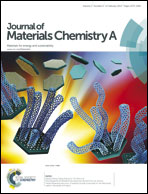In situ growth of mirror-like platinum as highly-efficient counter electrode with light harvesting function for dye-sensitized solar cells†
Abstract
In this work, we prepared a continuous nanostructured Pt-mirror film with metallic lustre and good adhesion to the F-doped tin oxide conducting glass (FTO) substrate through a simple in situ growth method, which retains a good catalytic activity and more importantly, exhibits significant light reflection for light-harvesting. The dye-sensitized solar cells (DSCs) fabricated with Pt-M CE exhibited superior photovoltaic performance compared with the conventional Pt CE. The enhancements of the short-circuit current density and energy conversion efficiency are 15.3% and 18.5%, respectively. Such significant enhancement of the short-circuit current density was found to be related to the excellent light reflection and high catalytic activity of the Pt-M CE. This has been proved by ultraviolet and visible reflection spectra (UV/Vis), electrochemical impedance spectroscopy (EIS) and cyclic voltammetry (CV).


 Please wait while we load your content...
Please wait while we load your content...